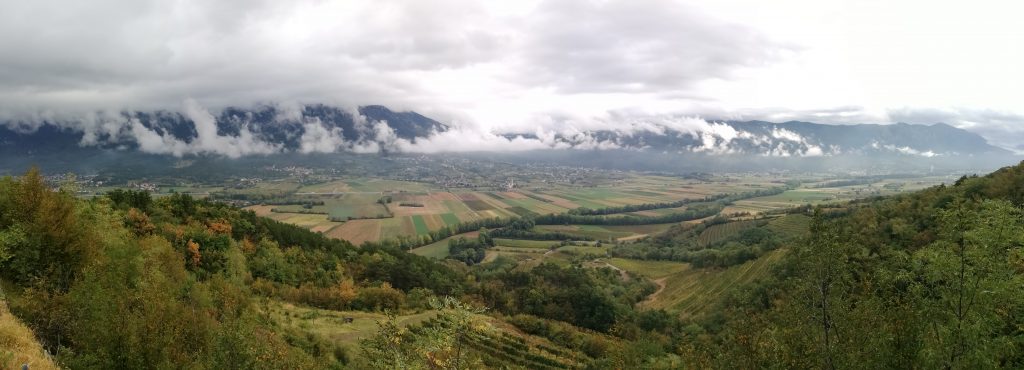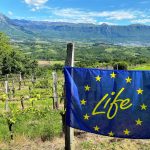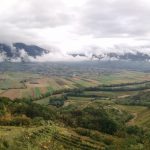DIFFERENT MEASURES FOR ADPTATION OF AGRICULTURE TO CLIMATE CHANGE
Partners of LIFE ViVaCCAdapt project (https://life-vivaccadapt.si/en/ https://www.facebook.com/LIFEViVaCCadapt) developed three different approaches to help agriculture adapt to climate change: DSSI system (Decision Support System for Irrigation) and Green Wind Breaks, which are intended for direct field application, and
Climate change adaptation strategy for agriculture in the Vipava Valley for the period 2017-2021 (Strategy), which offers a regulatory framework in terms of short-term guidelines in the field of agriculture.
The purpose of the Strategy is to strengthen the local capacity of the agricultural sector to adapt to climate change, manage climate-related risks (droughts, floods, frosts and strong winds) and take advantage of the opportunities in agriculture brought by climate change. With the strategy, partners obtained professional starting points, a set of priority measures and recommendations for the implementation of measures for the adaptation of local agriculture to climate change.
The second approach for adapting agriculture to climate change developed in the project is so-called Decision Support System for Irrigation or DSSI for short (more information https://www.mdpi.com/2073-4395/10/9/1238/htm?fbclid=IwAR0enLkHPzgJkg7yEpAz0yVscNjuS2_o6NkecpY2uEuHZoDlPHKoGlcY03o). Farmers from Vipava valley to join our initiative were invited and 35 farmers responded.
35 agricultural holdings from all over Vipava Valley started using the DSSI in 2019. The use of DSSI at the farm level is a technologically innovative measure that, through the implementation process, increases the level of knowledge in the field of professionally applied irrigation. Prior to entering the LIFE ViVaCCAdapt project, irrigation was done without information about the water content of the soil, weather forecasts or information on the needs of the plants in the specific growing phase.
The very establishment of the DSSI required a large number of preliminary activities. On plots where they wanted to have a system in place, we took samples of soil. Based on these samples, we created water retention curves of soil.
During the installation of the probes and before starting the system, we asked the farmers to also inform us about their water source and the type of irrigation system they use. These were the two sources of information we needed for the right way to set up DSSI. These data also provide us with input information regarding water consumption.
We launched the DSSI test run for the first time in irrigation season 2019. Until then, farmers were asked to irrigate their plants as usual. In this way, we obtained input data on water consumption without guidance and measurement, which allowed us to calculate water savings after the establishment of the DSSI system. Considering all (cross) input sources of information on water consumption, it turned out that water savings actually are present, but vary from farmer to farmer.
The DSSI system itself consists of several components, and the operation of the system is a complex process, which can be presented in the following simplified way. The hardware of the DSSI system consists of the TDR probe and the communication unit. The probe is installed in the plot, on which it is necessary to perform preliminary analyses of the soil and its water retention properties. Before using the system, we must also know what type of plants will consume water and in what phenophase it is. In this way we can determine the amount of water that the plant needs for optimal growth and development.
The DSSI is based on the calculation of the water balance using the irrigation-forecast model (IRRFIB) run by Slovenian Environment Agency. IRRFIB calculates the recommended irrigation time and instalment for 5 days in advance, taking into account:
- information on water retention properties of soil (field capacity, critical point, wilting point),
- current water content in the soil,
- the need of the plant for water according to the development phase and
- weather forecast (precipitation, evapotranspiration).
The calculation of the recommendation for irrigation is started every day during the growing season after 9 am (local time). When the results are available, DSSI users are automatically sent an e-mail with a recommendation for irrigation. The e-mail consists of three parts, namely:
- recommendations for irrigation, where the forecasts of evapotranspiration, precipitation and the recommended amount of irrigation water are given in tabular form,
- graphic display of the amount of water in the soil for the past 5 days, located in the e-mail attachment, and
- phenologies, namely
- current phenophases with the date of its occurrence,
- the following phenophases with an expected start date,
- previous phenophases with the date of its onset and
- links to a web interface where the current phenological phase can be changed.
Users can also access the DSSI via the web interface. The interface is designed on so called “Response mode” so that it can be used on all types of devices.
DSSI will be transferred to the national level within another project. Also the Slovenian Environment Agency will provide the system after the project ends. The tool will be developed into a public system to which any farmer in Slovenia will be able to connect. DSSI contributes to higher resilience of Slovenian agriculture to climate change and thus at the EU level contributes to the common goals of environmentally friendly agriculture.
Vipava valley has a reputation in Slovenia for its very strong wind called bora, and winter conditions that sometimes do not allow the ground to freeze. The Vipava Valley in Slovenia is known for its strong wind called BORA, which blows away even the freshly ploughed fertile land. The bora can blow at a speed of more than 200 km / h in exposed places during the winter months.
In the general recommendations for reducing the sensitivity of agricultural production to drought in Slovenia, autumn deep ploughing is recommended, which contributes to the soil freezing over the winter, which improves their structure. Thus, the soil collapses and thus re-establishes contact with the deeper layers of the soil, which later ensures the capillary flow of water to the surface. Autumn basic tillage allows for earlier sowing in spring. Spring and summer ploughing should be avoided, as by increasing the soil and bringing moist soil to the surface, it increases evaporation. Adherence to these recommendations in the area of the Vipava Valley would mean an increase in economic damage, as the bora can take away a lot of fertile land in the winter following ploughing fields in the autumn. This happens especially in the case when the soil does not freeze in winter and a strong bora wind appears which can carry fertile soil in the open fields. Filling of watercourses and drainage ditches and their non-conductivity for water during frequent heavy rainfall may mean the risk of major spills of waterflows in areas where these spills are not expected.
Therefore, for the Vipava Valley, to follow the above instructions, it makes sense to plant green windbreaks – GWB. One of the GWB definitions says that hedge is an independent line of woody vegetation, which, among other things, also acts as a windbreak. Another definition, however, states that GWBs are plantations of trees and shrubs that are usually planted in one or more lines in order to protect the soil (land) from the harmful effects of wind. The main goal of planting windbreaks is therefore to protect land from wind erosion and reduce water evaporation from open agricultural land.
In the past, arable land was smaller, and hedges grew freely between fields, protecting freshly cultivated (exposed) agricultural land from wind erosion. Due to the transition to a mostly mechanized method of land cultivation, trees and shrubs became a disruptive factor that reduced the profitability of agricultural production. For this reason, trees and shrubs were largely removed. Today we are once again learning about the versatile importance of trees or patches of forests and shrubs in the agricultural landscape and we are aware that inappropriate, ill-considered, sometimes even planned measures have caused great damage in the past.
However, the current situation and the significance of GWB are often discussed only during major weather events. One such happened in 2012, when a strong bora wind appeared at the end of January and in the first half of February blowing away more than 30,000 m3 of the most fertile land. After this extreme weather event, a partial analysis of the existing windbreaks was performed – a comparison between the planned, implemented and today preserved windbreaks. However, no evaluation of the effectiveness of existing windbreaks was performed in this analysis. We have prepared this as part of the Analysis in our project.
Today, in 2021, after more than 30 years since the first beginnings of planting, with the help of our project we are again on the right track to establish green windbreaks throughout the Vipava Valley. The Ministry of Agriculture of the Republic of Slovenia will allocate approx. 1.5 million EUR of funds to the replanting of 40 kilometres of GWB in next years.
We have learned something from the mistakes we have made in the past. This time we have taken action at the local level, informing farmers about the course of the campaign, resolving dilemmas with them and educating them about the importance of GWB. We believe that this time our work will bear fruit and that the measure will be well received and the GWB will remain (more information available at https://www.youtube.com/watch?v=PfuJZgJ7crI&t).
LIFE ViVaCCAdapt team







